Interest rate winners: who the Reserve Bank is helping financially
People feel financial pain more acutely than financial gain, helping explain the loud cries for borrowers while savers stay quiet about interest rate wins.

Opinion
Don't miss out on the headlines from Opinion. Followed categories will be added to My News.
They’re the quiet majority, inwardly smiling as the Reserve Bank of Australia continues its monthly barrage of interest rate increases – nine times in a row and counting.
Many may fear celebrating because they will be drowned out by the howls of pain and anger from those suffering huge increases in mortgage repayments after the RBA has pushed variable home loan interest rates 3.25 per cent higher since May 2022.
More anguish will be heard in the coming months as hundreds of thousands of borrowers come off fixed-rate deals struck near 2 per cent and revert to variable rates of more than 5.5 per cent. On a $500,000 mortgage, that’s a monthly repayment rise of $950 in one big whack.
However, it’s wise to remember that only about 35 per cent of Australians actually have a mortgage, and many of those are well ahead on their repayments or have small debts.
More than 30 per cent own their own homes outright, and a similar proportion are renters. Vastly more people have bank accounts – more than 99 per cent of us – and many have some form of savings, sharing in more than $1.3 trillion of household deposits.
Savers saw their deposit interest income drop to close to zero over the past decade, before bouncing back after the RBA started raising rates last year.

The top current deposit rate is 4.8 per cent, offered by ING, and a growing number of financial institutions are paying above 4 per cent – still below the latest annual inflation rate of 7.8 per cent but at least offering something to those who like to hoard cash.
Higher interest rates help retirees who invest conservatively, afraid to own growth assets such as shares that can plunge in value by 10 or 20 per cent in a matter of months.
Fixed-interest investors, who buy government and corporate bonds, were hammered last year by the worst performance in decades, but now that rates everywhere are higher and generally flattening out, the RBA’s moves are good for them, too.
Higher interest rates assist first home savers by offering some return on the cash they are putting away. They also get some benefit from falling home values, with some forecasters predicting a 15-20 per cent price drop for property.
Many of Australia’s 2.2 million residential real estate investors are helped by higher rates, to some degree. Rate rises go hand-in-hand with higher inflation, which is delivering landlords more rental income – although those with big mortgages on their properties are still worse off after their repayments jumped almost 50 per cent in less than a year.
Finally, these rapid-fire rate rises are probably better for the economy long-term than the alternative – persistently high inflation that weakens the value of our money. If we’re going to experience pain from the RBA’s rate moves, they may as well get it over quickly.
The Commonwealth Bank has predicted the RBA will need to start cutting rates this year to avoid a recession, so relief may not be far away.
While there are plenty of rate rise winners, we can’t ignore recent home buyers who have watched their property value plunge below its purchase price at the same time their mortgage repayments surged.
They are in a world of pain, with many parents and grandparents sharing their stress. Hopefully, their pain will be over relatively soon.
More Coverage
Originally published as Interest rate winners: who the Reserve Bank is helping financially





